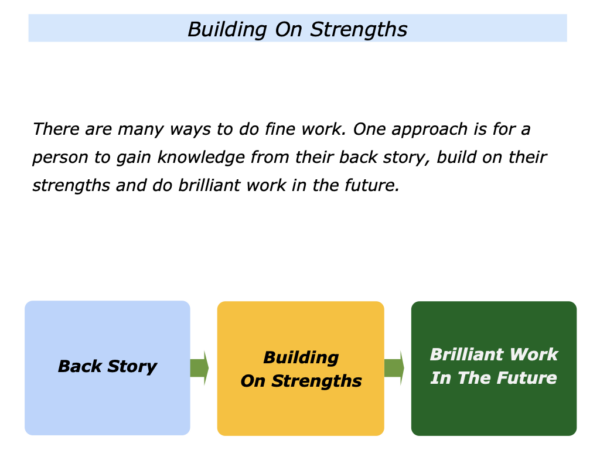
There are many ways to do fine work. One approach is for a person to gain knowledge from their back story, build on their strengths and do brilliant work in the future. Let’s explore these themes.
Back Story
Imagine that a person has asked you to help them to develop. Sometimes it can be helpful to know their back story. It is then possible help them to clarify and apply what they have learned during their lives.
Everybody has a back story. They have experienced and done many things in their lives. Some people use their back story as an opportunity to grow and help other people. Some may choose another route.
Different people have different back stories. They may have had a happy childhood, had difficult parents or grown up on a tough estate. They may have been good at school, been dyslexic or had other learning challenges.
They may have left school early, earned their own money and forged their own path. They may have been successful at sport and then had a severe injury. They may now work in a big company, enjoy their work or have a challenging boss.
Bearing these things in mind, it can sometimes be useful help them to gain knowledge from their back story. You can invite a person:
To describe their back story;
To describe the knowledge they have gained – such as what has worked and what they could do better in the future;
To invite them to build on what they have gained from this knowledge.
You will have your own approach to helping a person to clarify what they have learned. If appropriate, however, you can invite them to explore the following themes.
What is their back story? What have they done and experienced? What have been their successes? What did they do right to achieve these successes? What have been their setbacks and how have they recovered?
What have been the choices they made in their life or wok? What have been the consequences? What have they learned from making these choices?
Looking back, what is the knowledge they have gained? What have they learned about: a) what works; b) what does not work? How can they use this knowledge to grow or help other people?
Imagine that a person has described their back story. If appropriate, you can then invite them to explore the next theme.
Building On Strengths
Different people use their back story in different ways. Some use it as a resource for building on their strengths, setting specific goals and doing superb work. Some may use it as a reason for refusing to develop.
During the past fifty years I have worked with many people who chose the first option. These included individuals who took the following steps.
A woman who grew up in care decided to have children and become the best parent she could be. A dyslexic person learned to harness their creative ability, go into sales and eventually become the CEO of a giant technology company.
A footballer whose career ended early through injury became the youngest person to get the UEFA Pro Licence – the highest in the game. They went on to make a living acting as an advisor to elite football academies.
There many other examples of people who used their experiences to do superb work. Such individuals often aimed to build on what they can do rather than worry about what they can’t do.
Imagine that you are helping person to take this approach. If appropriate, you can help them to build on their strengths, set specific goals and achieve success.
One approach is for them to translate their strengths into doing a specific project. They may aim, for example:
To help people to have access to food, water and the basic materials for life … To help children who have difficulties in school … To help retiring sports people to find a new purpose … To build a successful prototype in their chosen field … To build a business … To do another activity.
There are many ways to help a person to take such steps. One approach is to invite them to focus on the following themes.
Strengths
What are the specific activities in which they deliver As rather than Bs or Cs? What are the things they feel passionately about where they may have the ability to deliver peak performance?
What are the activities that give them positive energy? When are they in their element – at ease and yet able to excel? What are the activities where they do superb work and have a track record of delivering success?
Specific Goals
How can they build on their strengths? How can they translate these into doing a specific project? Looking at this project, what may be the real results they want to achieve? What is the picture of success?
What are the key strategies they can follow to give themselves the greatest chance of success? How can they follow strategies that work? How can they translate these into a clear action plan?
Success
How can they follow their chosen strategies? How can they do superb work? How can they get some early wins? How can they anticipate and manage potential challenges?
How can they focus on continuous improvement? How can they follow their successful pattern for finishing? How can they do their best to achieve their picture of success?
Imagine a person has followed some of these steps and achieved their picture of success. If appropriate, you may also help them to focus on the following theme.
Brilliant Work In The Future
Some people are able to go into another dimension and do brilliant work. This can involve them focusing on a specific activity where: a) they do what they believe in; b) they do the basics; c) they add the brilliance.
Different people do this in different ways. Let’s look at one person who followed these principles and passed on a positive legacy.
Nicholas Albery was a lovely and remarkable person who I had the good fortune to know. Born in 1948, he accomplished much in his short life. He was probably best known for setting up The Institute for Social Inventions.
The Institute build a formidable track record of enabling people to imagine and implement creative for tackling challenges. He defined a social invention as:
A new and imaginative way of tackling a social problem or improving the quality of life.
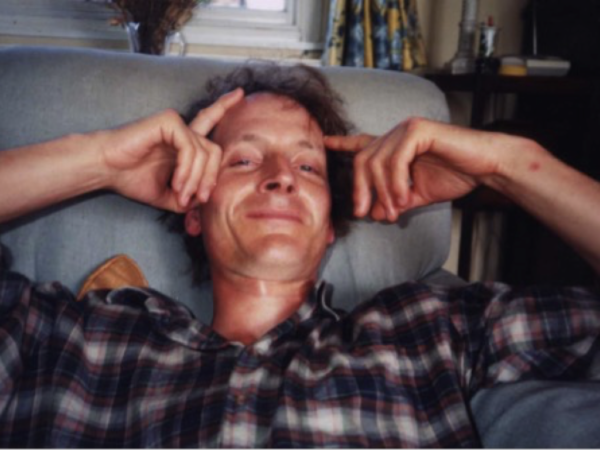
Writing the Foreword to The Book Of Visions: A Catalogue Of Social Inventions, Anita Roddick explained:
That is why I am so fond of the Institute for Social Inventions. We all have visions of a better world. Far too often we treat them as mere dreams, precisely because they are not linked to tasks.
The Institute gives voice to the many incremental but bold tasks people have invented to take us towards our visions – to make hope in this world.
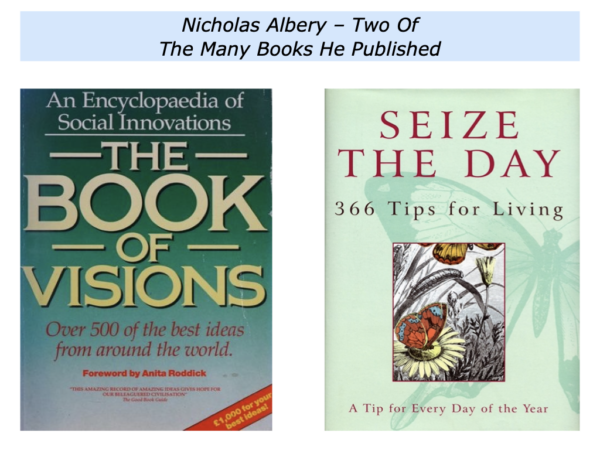
Incredibly generous, Nicholas inspired many people to use their talents to build a better world. Here are extracts from his Obituary in The Guardian, written by Walter Schwarz.
Nicholas Albery, who has died in a car crash aged 52, was a prolific social inventor, writer and activist. He was funny, exuberant and much loved.
His self-deprecating manner gave him a peculiarly English charm, which concealed the originality of his mind; most of his friends considered him a genius. Uninterested in fame for himself, his passion was to open up the search for innovation to all.
An intellectual hippie during the 1960s, he refused to shed his irreverence, and developed a passion for lateral thinking to fill gaps in social provision and improve the quality of life.
The Institute for Social Inventions, which he founded in 1984, with Edward de Bono, Anita Roddick and Fay Weldon among its patrons, collects non-technological innovations from around the world and gives £1,000 annual awards for the best ones.
Inventions which have been applied in practice have ranged widely in education, DIY and social and political life. They include a highly successful apprentice-master alliance directory, which has linked hundreds of would-be apprentices to master professionals in many fields.
Child-to-child counselling in primary schools, a children’s parliament and similar schemes have empowered children and adults to reinvent their world.
Albery and his wife Josefine Speyer, a psychotherapist, became interested in ecological approaches to death and funerals. In 1991, with Christianne Heal, they founded the Natural Death Centre, offering advice on DIY burials.
The much-patronised centre provides midwives for the dying, death exercises, recyclable coffins and The New Natural Death Handbook, now in its third edition.
Born at St Albans, Albery was the son of Sir Donald Albery, the impresario and theatre owner, and his wife Heather, and went to Stowe school. While a student at St John’s College, Oxford, he became involved with psychedelic and spiritual movements in San Francisco, dropped out of college and joined the anti-university in London.
In this period, his friendship began with Nicholas Saunders, whom he helped in setting up the popular Neal’s Yard wholefood complex of alternative enterprises in Covent Garden, London. Saunders died, also in a car crash, three years ago.
Albery’s life was full of irreverent gestures with a constructive purpose. In the late 1970s, he was a minister in the Frestonia Republic he helped to found, after the residents of Freston Road, in northwest London, threatened with eviction to make way for a factory, voted in favour of independence from Britain.
The Greater London Council held a public inquiry, where Albery represented the community. The area became a site for housing and craft workshops, and the foundation of the Notting Hill Housing Trust.
Albery is survived by his wife and their son Merlyn, who will bury him in private woodland, according to the wish he expressed in a book:
“When I die, I want to be buried under an apple tree. I think of death as like a leaf falling off a tree.”
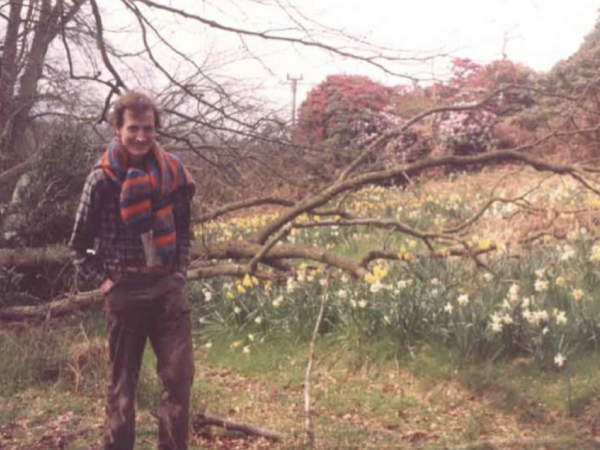
There are many ways to help people to develop. One approach is to focus on their back story, build on their strengths and help them to do brilliant work in the future.
Let’s return to your own life and work. Looking ahead, can you think of situation where you may want to follow elements of this approach? How can you do this in your own way?
If you wish, try tackling the exercise on this theme. This invites you to complete the following sentences.
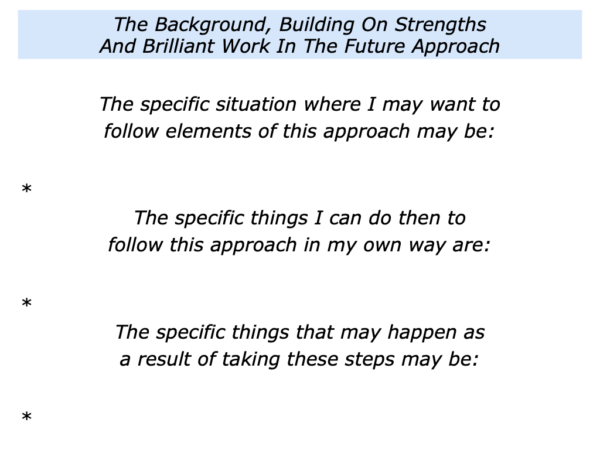






Leave a Reply